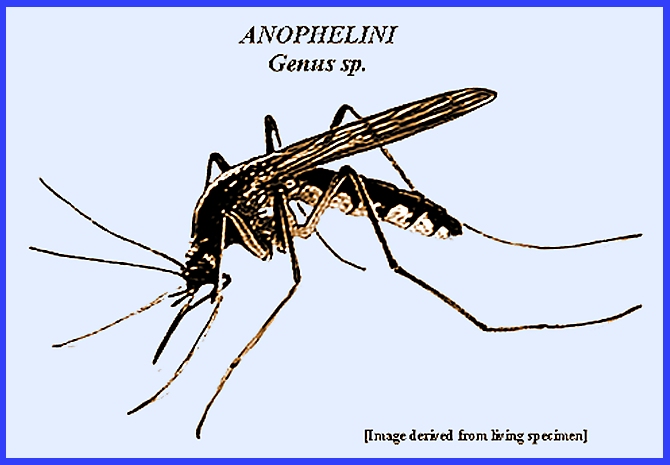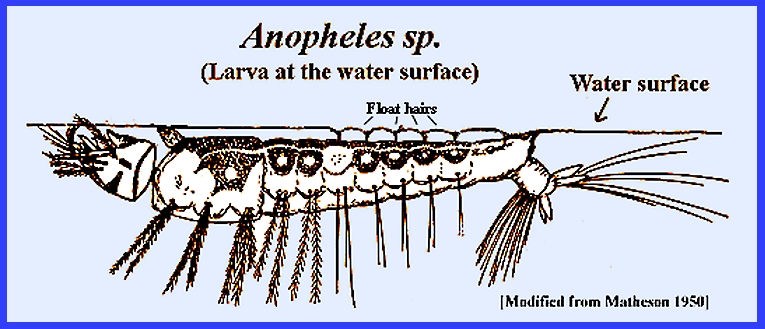|
ADULTS

1. The
scutellum has three slight lobes (occur in South America) _ _ _ _ _ _ Chagasia spp. Cruz
Scutellum is shaped like a crescent and is evenly rounded _ _ _ _ _
_ _ _ _ _ _ _ _ _ _ _ _ _ _ _ 2
The head is round. There are anterior prenotal
lobes or "collar" behind the head (Fig. 1) _ _ _ 6
2. The stem
of the wing's 2nd fork cell is wavy _ _ _ _ _ _ _ _ _ _ _ _ _ Bironella spp. Theobald
The
stem of the wing's 2nd fork cell is straight (Fig. 2) _ _ _ _ _ _ _
_ _ _ _ _ _ _ _ _ _ _ _ _ _ _ _ _ _ Anopheles spp.
Meigen 3
3. The thorax
is more or less black with a broad gray line from the neck to the
scutellum _ _ _ Subgenus: Stethomyia Theobald
Designs on the thorax are not like previously described _ _ _ _ _ _ _ _ _ _ _ _ _ _ _ _ _ _ _ _ _
_ _ _ _ _ _ _ _ _ _ _ _ _ _ _ _ _ _
4
4. Wings seldom have more than two pale
spots on the costa (Fig. 3). The sidepiece of male genitalis has 1-2
tough basal spines on
tubercles _ _ _ _ _ _ _ _
_ _ _ _ _ _ _ _ _ _ _ _ _ _ _ _ _ _ _ _ _ _ _ _ _ _ _ _ _ _ _ _ _ _ _ _ _ _
_ _ Anopheles spp.
Meigen
Wings
have 4 or more pale costal spots (Fig. 4) _ _ _ __ _ _ _
_ _ _ _ _ _ _ _ _ _ _ _ _ _ _ _ _ _
_ _ _ _ _ _ _ _ _ _ _ _ _ _ _ _ _ 5
5. The sidepiece of male genitalis has one
spine at its base and two beyond (American species) _ _ _ _ _ _ _ _ _ _ _ _ _ _ _ _ _ _ _ _
_ _ _ _ _ _ _ _ _ _ _ _ _ _ _ _ _ _ _ _ _ _ _ _ _ _ _ _ _ _ _ _ _ _ _ _ _ _
_ _ _ _ _ _ _ _ _ _ _ _ _ Subgenus: Nyssorhynchus Blanchard
Male
genitalis sidepiece has a few weak spines near its base that are not set on
tubercles (Old World species) _ _ _ _ _ _ _ _ _ _
_ _ _ _ _ _ _ _ _ _ _ _ _ _ _ _ _ _ _ _ _ _ _ _ _ _ _ _ _ _ _ _ _ _
_ _ _ _ _ _ _ _ _ _ _ _ _ _ _ _ Subgenus Myzomyia Blanchard
6. The head is
round. There are prenotal lobes or
collar behind the head. The hind leg has a paddle (Fig. 1)
(South American species)_
_ _ _
_ _ _ _ _ _ _ _ _ _ _ _ _ _ _ _ _ _ _ _ _ _ _ _ _ _ _ _ _ _ _ _ _ _ _ _ _ _
_ _ _ _ _ _ _ _ _ _ _ _ _ _ _ _ _ _ _ _ Sabethes spp.
LARVAE

7. The larva's body is
heavily clothed with short hairs in addition to the regular number of
hairs. There are leaflets of
palmate tufts considerably expanded apically and each ending in a long
central hair. The anterior flap of the
spiracular apparatus is extended into a long, heavy bristlelike structure _ _ _ _ _ _ _ _ _ _ _ _ _ _ _ _ _ _ _ _ _
_ _ _ _ _ Chagasia spp. Cruz
a. Larval body is not covered with fine
hairs. The leaflets of palmate
tufts are different from that described previously. There
is no elongation of the anterior flap of the spiracular apparatus_ _
_ _ _ _ _ _ _ _ _ _ _ _ _ _ _ _ _ _ _ _ _ _ _ _ _ _ _ _ _ _ _ 8
b. A dark sclerotized boss occurs at the
base of the ventral brush or hairs on the siphon occur singly_ _ _ _ _ _ _
_ _ _ _ _ _ _ 9
8. There are 2 pairs of
feathery hairs on the thorax_ _ _ _ _ _ _ _ _ _ _ _ _ _ _ _ _ _ _ _ _ _ _ _
_ _ __ _ _ Bironella
spp. Theobald
Feathery hairs on the thorax do not exceed one-pair (Fig. 5
& Fig. 6) _ _ _ _ _ _ _
_ _ _ _ _ _ _ _ _ _ Anopheles spp.
Meigen
9. A Pecten is present on
the siphon. The ventral brush has more than one pair of hairs and a dark
boss occurs at its base. Hairs
on he siphon are scarce or
absent _ _ _ _ _ _ _ _ _ _ _ _ _ _
_ _ _ (Fig. 7) (South American species) Haemagogus spp.
There
are no pecten or dark boss present, & ventral brush has only one pair
of hairs, and hairs on the siphon occur singly
(Fig. 8) (South American species) _ _ _ _ _ _ _ _ _ _ _ _ _ _ _ _ _ _ _ _ _ _ _ _ _ _ _ _ _ _ _
_ _ _ _ _ _ _ Sabethes spp.
|

